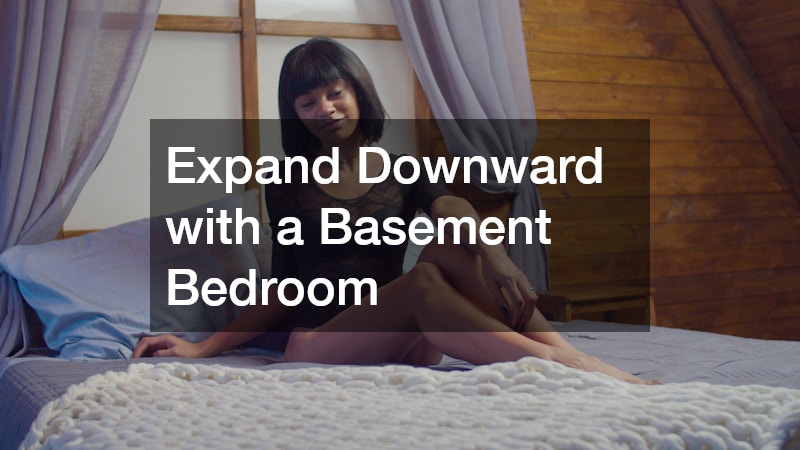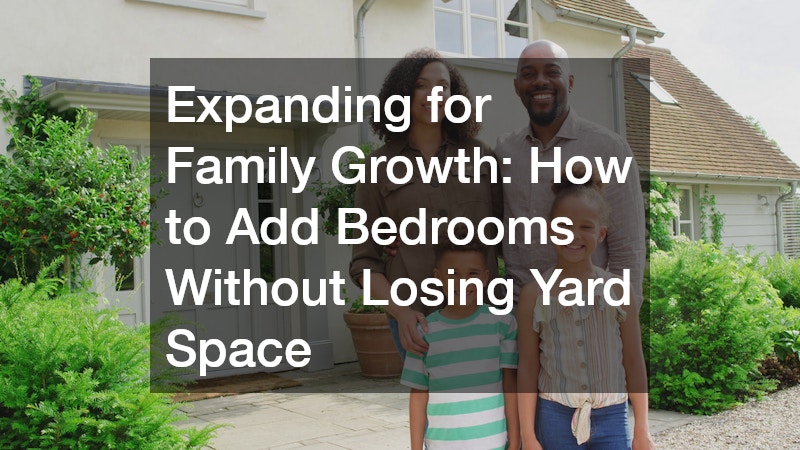Growing families often face the same challenge: more kids, more stuff, and not enough bedrooms. Moving is one option, but sometimes your current home has everything you love—good neighborhood, great schools, and that yard you’ve invested so much time into. The good news? You don’t have to give up your outdoor space to create more bedrooms. There are plenty of creative ways to expand your living space without encroaching on your yard. Let’s dive into the options.
Can Your Home Handle an Expansion?
Before you start dreaming about a luxurious new bedroom or a cozy attic hideaway, it’s crucial to know if your home can actually support the changes. Some homes are more structurally suited to expansion than others, and understanding the limits early can save you time, money, and stress.
Examine the Foundation, Walls, and Roof
Start by examining the foundation, walls, and roof. Homes built in the last few decades often follow modern building codes, which means they might handle an extra story or basement with relative ease. Older homes, however, might need structural reinforcements. It’s always smart to get a professional inspection before you plan major additions.
Familiarize Yourself With Local Zoning and Building Codes
Another consideration is your local zoning and building codes. Municipalities often have rules about how high you can build, how close additions can be to property lines, and whether you need permits for certain renovations. Knowing these regulations upfront helps you avoid expensive setbacks later.
You should also think about your family’s lifestyle. How many bedrooms will you realistically need, and how will they fit into your current floor plan? Understanding your priorities will guide your decisions as you explore different expansion strategies.
Go Up, Not Out: Adding a Second Story

When yard space is limited, building upward is usually your best bet. Adding a second story can dramatically increase your living space while leaving your outdoor area intact. It’s like doubling your home without moving an inch.
The process typically involves reinforcing the existing foundation and walls, installing new support beams, and designing a staircase that flows naturally from the first floor. Lumber materials play a central role here, from framing walls and floors to supporting the roof structure. For heavier items like trusses, beams, or prefabricated panels, crane rentals can make lifting and positioning much safer and faster.
Working with a skilled contractor or architect can make the project manageable and safe, ensuring everything meets local building codes.
Benefits of going vertical:
-
Preserves your yard for outdoor play, gardening, or entertaining.
-
Creates a clear separation between living areas and bedrooms.
-
Offers potential for spectacular views, depending on your location.
Keep in mind that adding a second story requires careful planning for plumbing, heating, and electrical systems. You’ll also want to think about insulation and soundproofing so the new bedrooms feel comfortable and private.
Make the Most of Your Garage Space
Garages are often underutilized areas in homes. Converting a garage into a bedroom can be a surprisingly efficient way to add living space without touching your yard. Whether your garage is attached or detached, there’s potential to transform it into a cozy bedroom, home office, or even a multi-purpose room.
Start by ensuring proper insulation and ventilation. Garages aren’t typically built for year-round living, so you’ll want to maintain comfortable temperatures in all seasons. Hiring professional spray foam insulation services can help seal gaps, improve energy efficiency, and keep the new bedroom cozy in both summer and winter. You’ll also want to ensure proper lighting and electrical outlets, which is where a licensed residential electrician can step in to safely handle wiring and any upgrades.
Consider adding windows or skylights to bring in natural light, making the space feel less like a garage and more like a real bedroom.
Garage conversion ideas:
-
Add built-in storage to maximize floor space.
-
Include an en-suite bathroom if plumbing is accessible.
-
Use fold-out or Murphy beds to maintain flexibility.
Keep in mind, converting a garage may reduce your parking space. If you rely on your garage for cars, you might need a carport or driveway extension to make up for the lost space.
Turn the Attic Into a Cozy Hideaway

Attics are often overlooked, dusty spaces that seem impossible to use. With the right planning, however, your attic can become a warm, inviting bedroom for kids, guests, or even a quiet home office.
Before you start, check the height and structure. A functional bedroom requires enough headroom to stand comfortably, and the floor must support the weight of furniture. Reinforcing beams or installing additional support might be necessary. You may also want to consult a roofing company to ensure your roof is in good condition and can handle any new loads, especially if you plan to add dormers or skylights.
Tips for Attic Transformations
-
Bring in natural light: Use dormer windows to increase headspace and sunshine.
-
Maximize storage: Consider built-in shelves or under-eave storage to make the most of every inch.
-
Create a cozy vibe: Choose light colors, soft lighting, and cozy textiles to make the space feel larger and more inviting.
-
Highlight unique features: Sloped ceilings and nooks can be turned into reading corners, play areas, or quiet retreats, giving the attic a special charm.
Expand Downward with a Basement Bedroom

If you’ve got a basement that’s mostly used for storage or laundry, you might be sitting on untapped potential. Converting a basement into a bedroom can give your family extra space while keeping your yard intact.
Start by addressing moisture issues. Basements are prone to dampness, so it’s important to waterproof walls, install proper drainage, and consider a dehumidifier. If you need to lower the floor to increase ceiling height or create window wells, some excavation may be required. During this process, rebar fabrications are often used to reinforce the foundation or new walls, ensuring the space is structurally sound. Once the area is dry and secure, you can add flooring, lighting, and heating to make it livable.
Basement Bedroom Advantages
-
Keeps bedrooms separate: Ideal for older kids or guests, providing privacy from main living areas.
-
Multi-purpose space: Can double as a media room, study space, or playroom when not in use.
-
Cost-effective expansion: Often more affordable than building a second story.
It’s worth noting that some basements have limited ceiling height or small windows. Creative design choices, like lowering the floor slightly or enlarging window wells, can make the space feel airy and welcoming.
Reimagine the Space You Already Have
Sometimes the best way to gain a bedroom isn’t to expand at all but to rethink the layout of your current home. By optimizing the space you already have, underused areas can be transformed into functional, comfortable sleeping quarters without major construction.
Start by looking at rooms with flexible uses. A home office that’s rarely occupied could easily become a bedroom, while a formal dining room might double as a kid’s bedroom or a guest suite. You can use partitions, sliding doors, or clever furniture arrangements to carve out private areas while keeping the space open and functional.
Creative Ways to Repurpose Space
-
Transform storage areas: Large closets, walk-in pantries, or storage rooms can be converted into compact bedrooms with a little planning and smart design.
-
Use lofts and open areas: Open loft spaces or mezzanines can become sleeping zones when paired with privacy screens, curtains, or half-walls.
-
Maximize vertical space: In shared rooms, consider bunk beds or loft beds to create multiple sleeping areas while leaving floor space for other activities.
-
Flexible furniture solutions: Murphy beds, fold-out sofas, or modular furniture can allow a room to serve multiple purposes without feeling cramped.
-
Nooks and alcoves: Unused corners or alcoves under staircases can be turned into cozy sleeping spots for kids or guests.
Reimagining your existing space not only saves time and money compared to full-blown bedroom additions but can also inspire creative design solutions that make your home feel larger, more functional, and uniquely tailored to your family’s needs.
Think Modular: Quick Add-Ons with Minimal Disruption
If you’re looking for a faster solution, modular additions or prefabricated units can be an excellent option. These structures are built off-site and then installed on your property, often requiring less construction time and minimal yard disturbance.
Modular units can serve as bedrooms, playrooms, or even home offices. They’re particularly useful when you need temporary accommodations or want to avoid extensive construction mess inside your home.
Benefits of modular additions:
-
Less disruption to daily life during construction.
-
Often more cost-effective than traditional builds.
-
Can be designed to blend seamlessly with your existing home.
Keep in mind that zoning restrictions and foundation requirements may still apply. However, for families needing extra space quickly, modular solutions offer a flexible and practical alternative.
Design with Family Comfort in Mind

Adding bedrooms isn’t just about square footage—it’s about creating spaces where your family feels comfortable and happy. Thoughtful design can make even small bedrooms functional, cozy, and attractive.
Consider your family’s routines and privacy needs. Bedrooms for teenagers may need more soundproofing, while a nursery requires safety features and easy access for parents. Lighting, ventilation, and storage are all crucial factors in creating a space that’s practical and pleasant. Working with architect design firms can help you maximize space, balance aesthetics with function, and ensure each bedroom flows seamlessly with the rest of the home.
Design Tips for Family Comfort
-
Flexible furniture: Choose loft beds, trundle beds, or built-ins to make the most of limited space.
-
Smart storage: Incorporate solutions that reduce clutter and keep rooms tidy.
-
Calming aesthetics: Use soothing color palettes and textures to create a restful environment.
-
Multi-functional spaces: Remember, a bedroom can also serve as a play area, study nook, or small home office while remaining a private sanctuary.
-
Layered lighting: Combine overhead, task, and accent lighting to create a warm, versatile atmosphere.
-
Acoustic considerations: Add rugs, curtains, or wall panels to reduce noise and improve comfort for light sleepers.
-
Personal touches: Incorporate artwork, family photos, or themed décor to make the space feel inviting and unique.
-
Temperature control: Ceiling fans, smart thermostats, or portable heaters/coolers can ensure comfort year-round.
-
Easy-access storage: Low drawers or baskets for toys, clothes, or school supplies help kids keep their rooms organized independently.
Plan Your Budget and Bring in the Pros
No matter which approach you choose, budgeting is key. Expansion projects can quickly become costly if you underestimate construction, permits, materials, or labor. Creating a detailed budget early helps you make informed decisions and avoid surprises.
Hiring professionals is almost always worth it. Architects, contractors, and designers bring expertise that ensures your addition is safe, functional, and aesthetically pleasing. They can also guide you through permits, inspections, and any unexpected challenges that pop up during construction.
For certain tasks, having the right tools on hand can make a huge difference. For example, equipment rental for heavy lifting, demolition, or foundation work can save time and reduce physical strain, especially if you don’t plan to buy specialized tools yourself.
Keeping the job site organized is equally important. Planning for dumpster rentals early ensures that debris and construction waste don’t clutter your yard or workspace, making cleanup easier and keeping the project running smoothly.
Budgeting and Planning Tips
-
Get multiple quotes: Compare contractors to find a fair price.
-
Set aside a contingency fund: Be prepared for unexpected expenses.
-
Prioritize features: Focus on necessities first, then consider luxury upgrades.
-
Plan for long-term costs: Include heating, cooling, and maintenance in your calculations.
Well-thought-out bedroom additions not only improve your living space but also boost the value and comfort of your home for years to come.
Wrapping It Up
Expanding for family growth doesn’t have to mean sacrificing your yard or moving to a bigger property. With thoughtful planning and creative solutions, you can add bedrooms that suit your family’s needs, blend seamlessly with your existing home, and maintain the outdoor space you love. From going vertical with a second story to reimagining unused spaces, there’s a strategy for nearly every home.
Take the time to assess your home, work with professionals, and design spaces that prioritize comfort and functionality. The result? A home that grows with your family, without losing the elements that make it special.



















